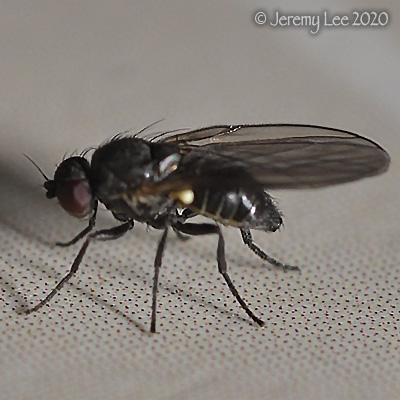
 |
|
Scientific Classifications explained » Amphibians » Ants » Aphids » Bees » Beetles » Birds » Bugs » Butterflies » Caterpillars » Damselflies » Dragonflies » Earwigs » Flies » Frog/Leafhoppers » Fungi » Galls » Grasshoppers » Harvestmen » Hoverflies » Lacewings » Ladybirds » Leaf Mines » Lichens » Mammals » Millipedes » Mosses » Moths » Sawflies » Slugs » Snails » Spiders » Trees & Shrubs » Wasps » Wild Flowers » Woodlice » Postboxes |
UK Nature > Flies > Phytomyza ilicis

Scientific Name: Phytomyza ilicis Common Name: Holly Leaf Miner Phytomyza ilicis is a fly that lays its eggs in holly leaves. It is one of the few insects that are able to make use of holly leaves as a food source and somewhere to live (when a larva). The female fly lays eggs in the holly leaf (near the main veins or midrib, on the underside) using a thin tube or ovipositor. The eggs are usually laid in early Spring when there are young and ‘soft’ leaves. Older leaves have a thick and tough cuticle that is far more difficult to penetrate. The larvae emerge from the eggs and tunnel their way along the midrib / veins emerging some time later into the lamina or blade of the leaf. Here they feed on the photosynthetic tissues of the leaf – the palisade and mesophyll layers, creating a leaf mine. The number of leaf mines per leaf is a maximum of three and often just one or two. After a period of feeding, the larva turns into a pupa from which an adult fly emerges. It exits the leaf mine via a small hole (less than a millimetre in diameter). These may be seen on the leaf surface. |
|

https://www.uknature.co.uk is a website dedicated to showing the immense diversity of UK nature and wildlife. Our vast range of habitats, from lowland arable to snow covered mountains, from storm-ravaged coastlines to peaceful inland freshwater lakes and rivers, from dry, sandy heaths to deciduous and coniferous forests, all these habitats contribute to the abundance of UK nature. We have wild birds in huge numbers either residing or visiting our shores (597 recorded species as at July 2013) and we must also not forget the humble back garden with its grass lawns, flower beds filled with nectar rich flowers, shrubs and trees, all designed to attract huge numbers of insects such as bees, moths, butterflies and hoverflies; and finally the small ponds which provide safe havens for frogs, toads, newts and even slow worms and grass snakes. www.uknature.co.uk is the showcase for my personal passion, photographing uknature in all its glory. I sincerely hope you all enjoy the fruits of my labours. This site and all images contained therein is © Jeremy Lee 2004 - 2025. All Rights Reserved. Site design by Jeremy Lee. Site development & IT Support by Stuart Lee. |